
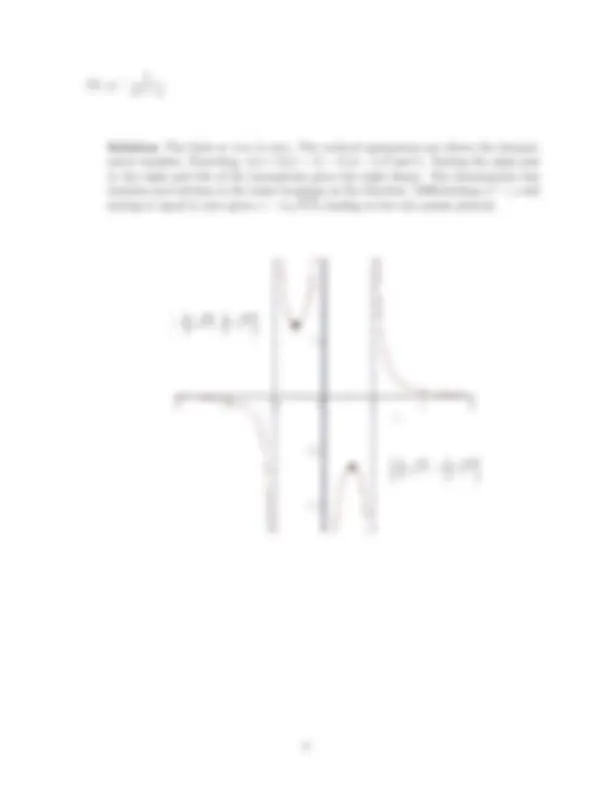
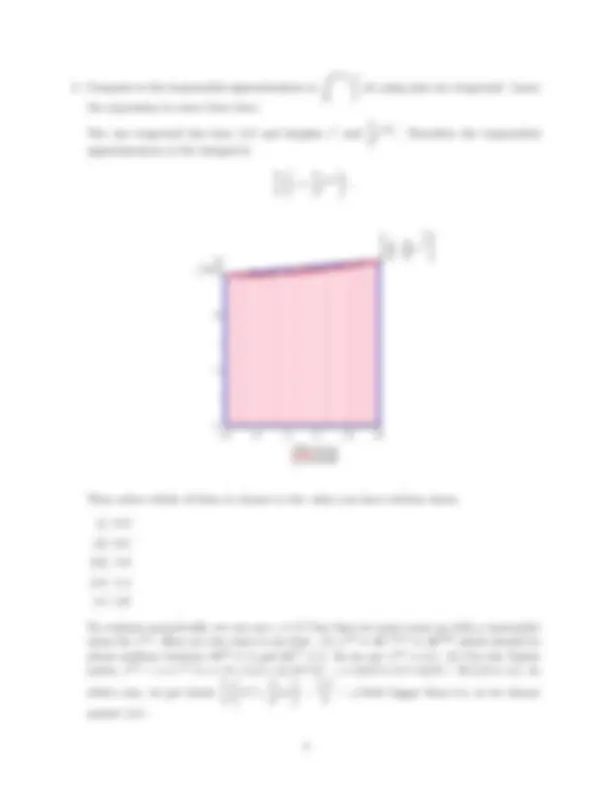
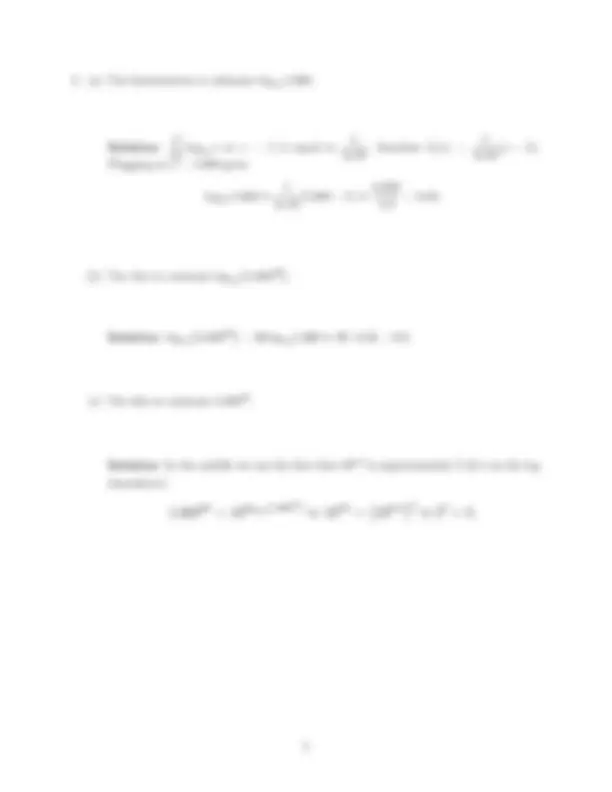
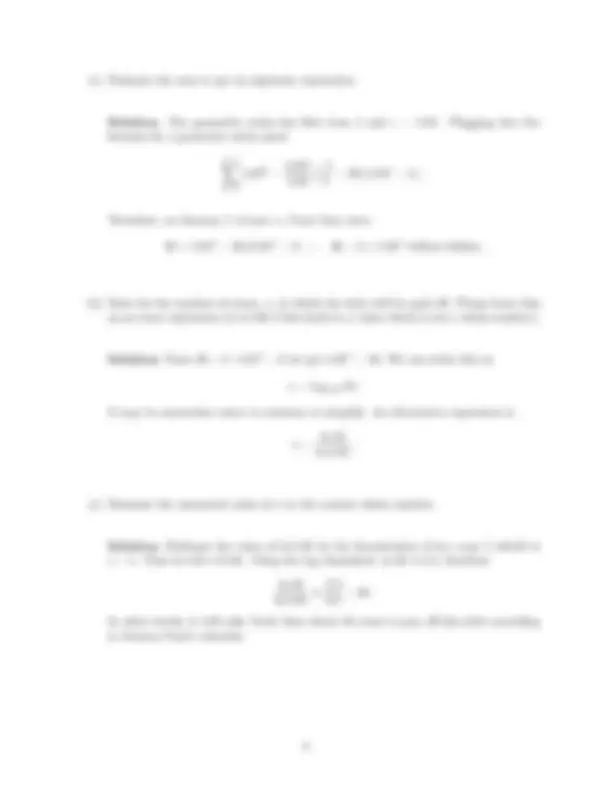
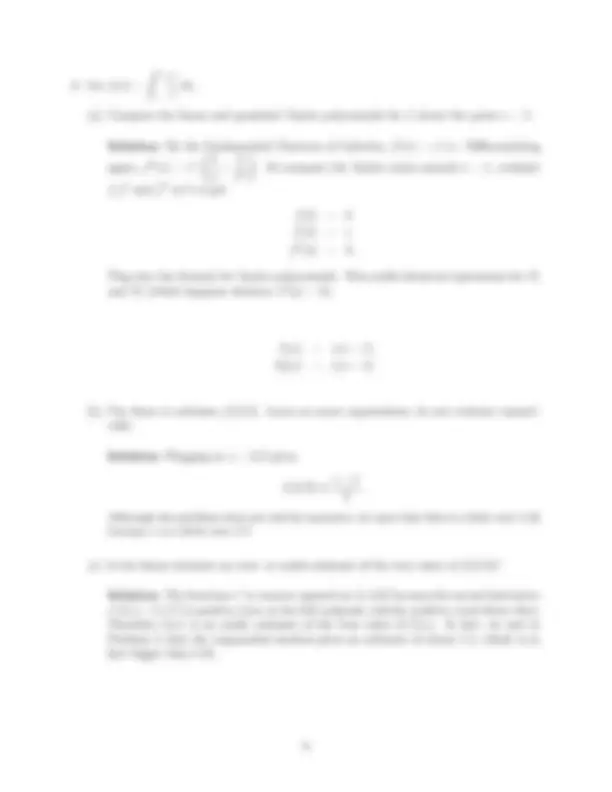
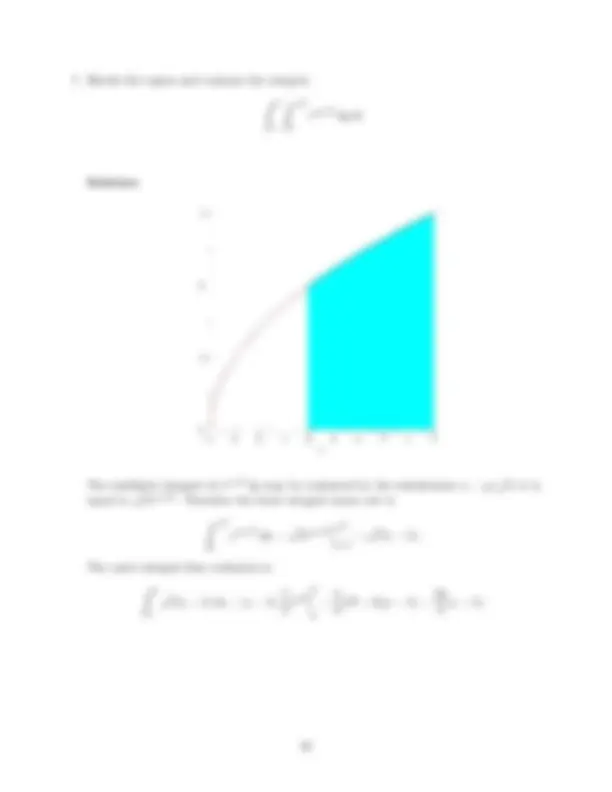
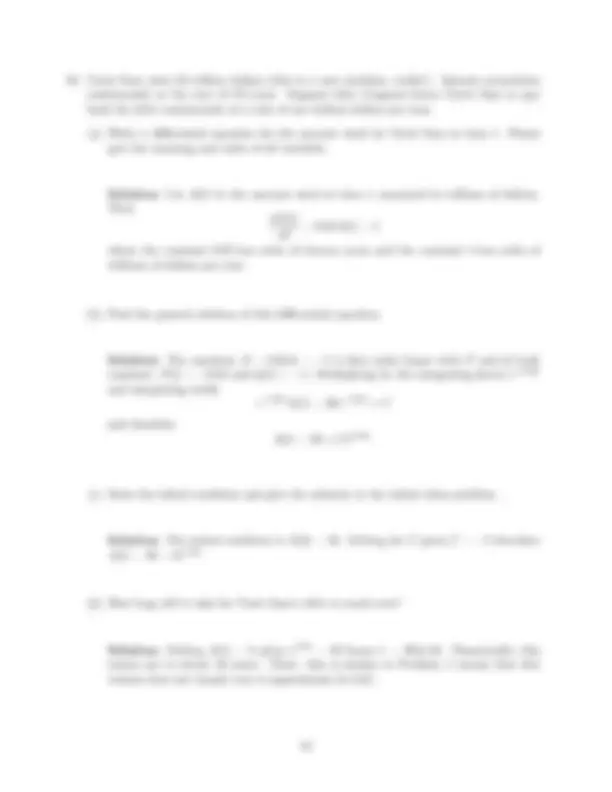
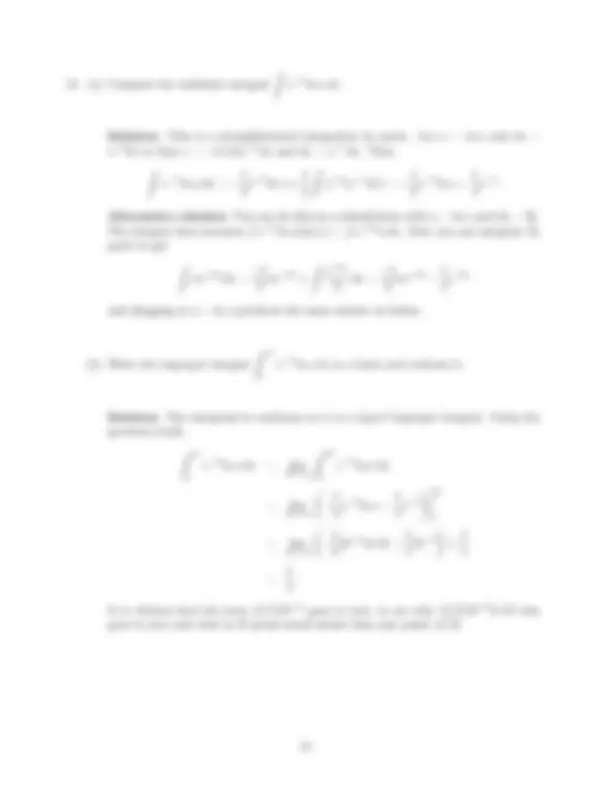
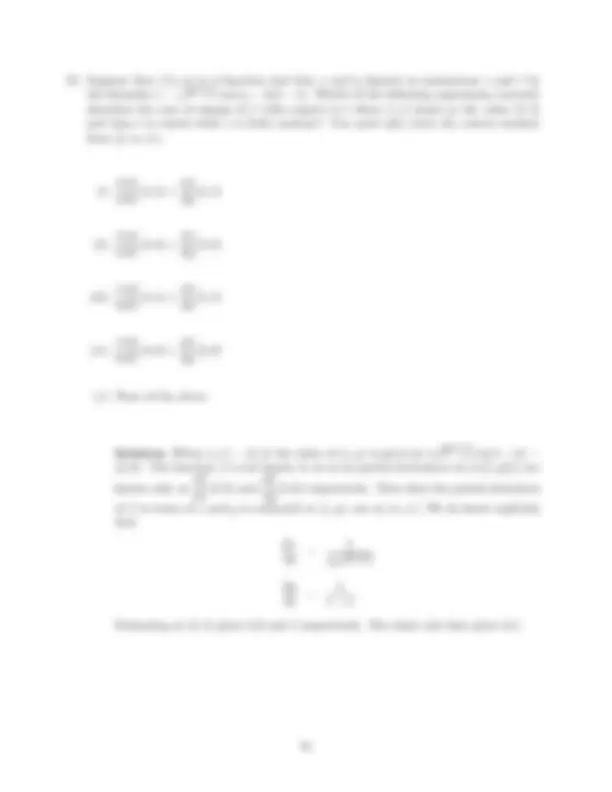
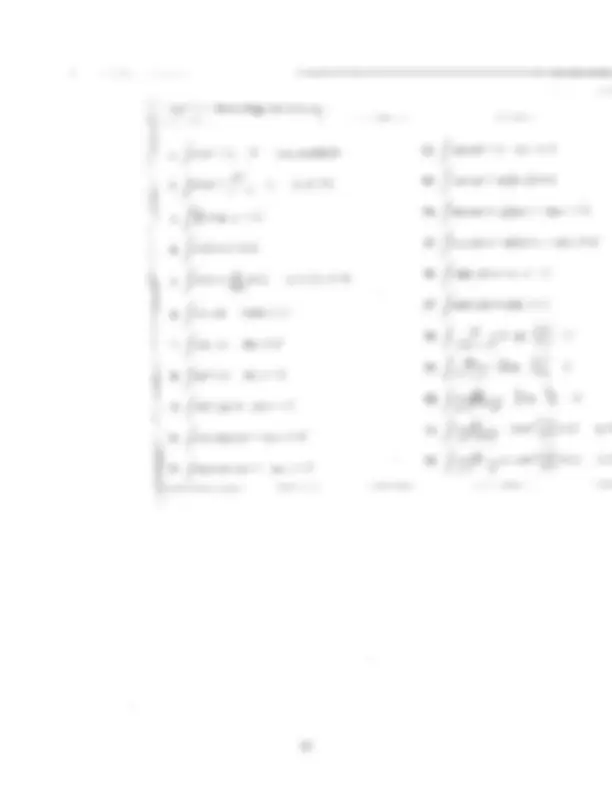


Study with the several resources on Docsity

Earn points by helping other students or get them with a premium plan


Prepare for your exams
Study with the several resources on Docsity

Earn points to download
Earn points by helping other students or get them with a premium plan
Community
Ask the community for help and clear up your study doubts
Discover the best universities in your country according to Docsity users
Free resources
Download our free guides on studying techniques, anxiety management strategies, and thesis advice from Docsity tutors
Give the general solution of the differential equation (1 + t)y + y = √t. ... Using the log cheatsheet, ln10 ≈ 2.3, therefore.
Typology: Summaries
1 / 18

This page cannot be seen from the preview
Don't miss anything!











(a) y =
ex x
Solution: The limit at −∞ is zero (use L’Hˆopital’s rule). The x in the deniminator produces a vertical asymptote at x = 0, with the function positive to the right and negative to the left. There is just one minimum, which may be found by diferentiating.
d dx
ex x = ex
x
x^2
which vanishes at x = 1.
1
ex x dx using just one trapezoid. Leave the expression in exact form here.
The one trapezoid has base 1/2 and heights e^1 and
e^3 /^2. Therefore the trapezoidal approximation to the integral is
1 4
e +
e^3 /^2
Then select which of these is closest to the value you have written down. (i) 0. (ii) 0. (iii) 1. (iv) 1. (v) 2.
To evaluate numerically, we can use e ≈ 2 .7 but then we must come up with a reasonable value for e^3 /^2. Here are two ways to do that. (1) e^3 /^2 ≈ 101.^5 /^2.^3 ≈ 100.^65 which should be about midway between 10^0.^6 ≈ 4 and 10^0.^7 ≈ 5. So we say e^3 /^2 ≈ 4 .5. (2) Use the Taylor series: e^3 /^2 = e ∗ e^1 /^2 ≈ e ∗ (1 + 1/2 + (1/2)^2 /2) = e ∗ 13 / 8 ≈ 2. 7 ∗ 13 /8 = 35. 1 / 8 ≈ 4 .5. In either case, we get about
= a little bigger than 1.4, so we choose answer (iv).
Solution: d dx log 10 x at x = 1 is equal to
ln 10 , therefore L(x) =
ln 10 (x − 1). Plugging in x = 1.069 gives
log 10 1. 069 ≈
ln 10
(b) Use this to estimate log 10
Solution: log 10
= 30 log 10 1. 069 ≈ 30 · 0 .03 = 0.9.
(c) Use this to estimate 1. 06930.
Solution: In the middle we use the fact that 10^0.^3 is approximately 2 (it’s on the log cheatsheet):
(^30) )
(a) Write expressions for the amount owed by Uncle Sam on January 1 of 2015, 2016 and
Solution: Each year the new debt is the old debt multiplied by 1.05, with one trillion subtracted. This give the following table.
date debt in trillions of dollars Jan 1, 2015 18 Jan 1, 2016 18 × 1. 05 − 1 Jan 1, 2015 18 × 1. 052 − 1. 05 − 1
(b) Write an expression using Sigma notation for how much Uncle Sam owes on January 1 of year n, counting 2015 as year 0.
Solution: After year n, Uncle Sam’s debt is given by
18 × 1. 05 n^ −
∑^ n−^1
k=
(c) Evaluate the sum to get an algebraic expression.
Solution: The geometric series has first term 1 and r = 1.05. Plugging into the formula for a geometric series gives
∑^ n−^1
k=
Therefore, on January 1 of year n, Uncle Sam owes
18 × 1. 05 n^ − 20 (1. 05 n^ − 1) = 20 − 2 × 1. 05 n^ trillion dollars.
(d) Solve for the number of years, n, in which the debt will be paid off. Please leave this as an exact expression (it is OK if this leads to a value which is not a whole number).
Solution: From 20 − 2 · 1. 05 n^ = 0 we get 1. 05 n^ = 10. We can write this as
n = log 1. 05 10.
It may be somewhat easier to continue to simplify. An alternative expression is
n = ln 10 ln 1. 05
(e) Estimate the numerical value of n to the nearest whole number.
Solution: Estimate the value of ln 1.05 by the linearization of ln x near 1 whicih is x − 1. Thus ln 1. 05 ≈ 0 .05. Using the log cheatsheet, ln 10 ≈ 2 .3, therefore ln 10 ln 1. 05
In other words, it will take Uncle Sam about 46 years to pay off this debt according to Senator Paul’s schedule.
∫ (^9)
4
∫ √x
0
ey/
√x dy dx
Solution:
The indefinite integral of ey/
√x dy may be evaluated by the substitution u = y/
x; it is equal to
xey/
√x
. Therefore the inner integral comes out to ∫ √x
0
ey/
√x dy =
xey/
√x^ ∣∣ ∣
√x y=
x(e − 1).
The outer integral then evaluates to ∫ (^9)
4
x(e − 1) dx = (e − 1)
x^3 /^2
9
4
(27 − 8)(e − 1) =
(e − 1).
Solution: The wording of the problem may be translated into the equation
p = k
w a^2 where w is the weight (the problem suggests units of pounds), a is its age (units of years), and p is the price of the turkey (units of in dollars or your favorite medieval currency). The proportionality constant k then has units of dollars times years squared per pound.
The problem calls for us to evaluate da/dw along the level curve where p is constant, throught the point (w, a) = (10, 1). We use the formula da dw
pw pa
. The partial deriva- tives of p(w, a) are given by ∂p ∂w (w, a) = k a^2 ∂p ∂a (w, a) = − 2 kw a^3
Therefore, da dw
pw pa
k/a^2 2 kw/a^3
a 2 w
Evaluating at the point (10, 1) gives 1/20. Thus, for each pound more tha Jack needs, he must be willing to accept a turkey 1/20 year older and tougher. [Note that the units are in years per pound, which is consistent with computation we are trying to compute how mthat it represents how many more years the turkey will have per ound of extra weight.]
Solution: Let A(t) be the amount owed at time t, measured in trillions of dollars. Then dA(t) dt
= 0. 05 A(t) − 1 where the constant 0.05 has units of inverse years and the constant 1 has units of trillions of dollars per year.
(b) Find the general solution of this differential equation.
Solution: The equation A′^ − 0. 05 A = −1 is first order linear with P and Q both constant: P (t) = − 0 .05 and Q(t) = −1. Multiplying by the integrating factor e−^0.^05 t and integrating yields e−^0.^05 tA(t) = 20e−^0.^05 t^ + C and therefore A(t) = 20 + Ce^0.^05 t^.
(c) State the initial condition and give the solution to the initial value problem.
Solution: The initial condition is A(0) = 18. Solving for C gives C = −2 therefore A(t) = 20 − 2 et/^20.
(d) How long will it take for Uncle Sam’s debt to reach zero?
Solution: Setting A(t) = 0 gives et/^20 = 10 hence t = 20 ln 10. Numerically, this comes out to about 46 years. [Note: this is similar to Problem 4 except that this version does not require you to approximate ln 1.05.]
x−^3 ln x dx.
Solution: This is a straightforward integration by parts. Let u = ln x and dv = x−^3 dx so that v = −(1/2)x−^2 dx and dv = x−^1 dx. Then ∫ x−^3 ln x dx = −
x−^2 ln x +
x−^2 (x−^1 dx) = −
x−^2 ln x −
x−^2.
Alternative solution: You can do this as a substitution with u = ln x and du = dxx. The integral then becomes
x−^2 ln x(dx/x) =
e−^2 uu du. Now you can integrate by parts to get ∫ ue−^2 u^ du =
ue−^2 u^ +
e−^2 u 2 du =
ue−^2 u^ −
e−^2 u
and plugging in u = ln x produces the same answer as before.
(b) Write the improper integral
1
x−^3 ln x dx as a limit and evaluate it.
Solution: The integrand is continous so it is a type-I improper integral. Using the previous result, ∫ (^) ∞
1
x−^3 ln x dx = (^) Mlim →∞
1
x−^3 ln x dx
= (^) Mlim →∞
x−^2 ln x −
x−^2
M
1
= (^) Mlim →∞
M −^2 ln M −
It is obvious that the term (1/4)M −^2 goes to zero; to see why (1/2)M −^2 ln M also goes to zero note that ln M grows much slower than any power of M.
(i) P ′(t) = − 3 P (t) 300 − 2 t
(ii) P ′(t) = −1 + P (t) 3
(iii) P ′(t) P (t)
(iv) P ′(t) − P (t) = −
300 − t
(v) None of the above
Solution: The pool is filling at rate 1 m^3 / min and draining at rate 3 m^3 / min. Therefore, the amount of water in the pool at time t is 300 − 2 t cubic meters. If P (t) is the total amount of poison in the pool, the concentration of poison is P (t)/(300 − 2 t). The amount of poison leaving the pool is the concentration times the total outflow, which is 3m^3 / min times the concentration. Because no poison enters the pool, this is the rate of change of P (t) and it is negative. Thus the correct answer is (i).
Logarithm Cheat Sheet
These values are accurate to within 1%:
e ≈ 2. 7 ln(2) ≈ 0. 7 ln(10) ≈ 2. 3 log 10 (2) ≈ 0. 3 log 10 (3) ≈ 0. 48
Some other useful quantities to with 1%:
π ≈
22
√^7 10 ≈ π √ 2 ≈ 1. 4 √ 1 / 2 ≈ 0. 7
(ok so technically
√ 2 is about 1.005% greater than 1.4 and 0.7 is about 1.005% less than
√ 1 /2)
1